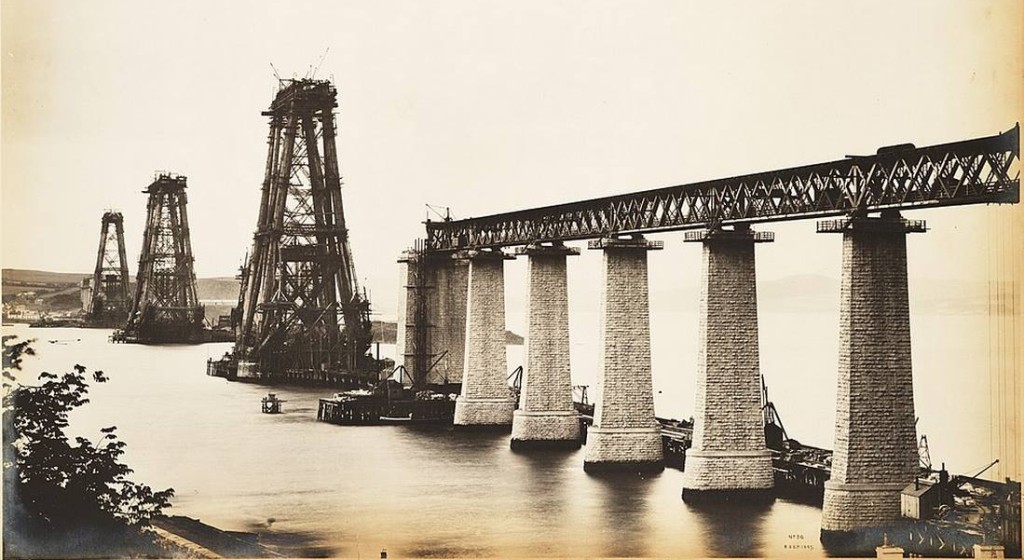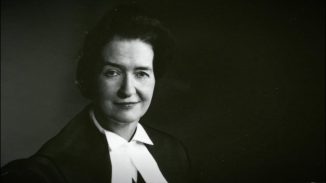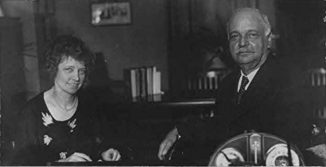133 years ago today, The Forth Bridge (not to be mistaken for the ‘fourth’ bridge) was opened for railway crossing over the Firth of Forth dividing Edinborough from Aberdeen. It is considered a symbol of Scotland’s brilliance (having been voted Scotland’s greatest man-made wonder in 2016) and is a UNESCO World Heritage Site for being the longest cantilever bridge in the world at one point. READ more about this engineering marvel… (1890)

Construction began in 1882 under the supervision of English engineers Sir John Fowler and Sir Benjamin Baker, the former of whom designed the London metropolitan underground, and the latter designed the Old Aswan Dam on the Nile River. These two minds came together to design the longest cantilever bridge in the world, a title it would hold for nearly 30 years. It remains the world’s second-longest.
The bridge used 55,000 tonnes (54,000 long tons; 61,000 short tons) of steel and 140,000 cubic yards (110,000 m3) of masonry. The four circular piers that would support each cantilever were constructed with cofferdams near the shore where work could be done at low tide, and caissons in the middle of the firth where water levels were constant; the latter being a box or airtight enclosure that’s lowered into the river. After which the water can be pumped out, and work can begin inside the box.
Load testing of the completed bridge was carried out on January 21st, 1890. Two trains, each consisting of three heavy locomotives and 50 wagons loaded with coal, totaling 1,880 tons in weight, were driven slowly from South Queensferry to the middle of the north cantilever, stopping frequently to measure the deflection of the bridge. This represented more than twice the design load of the bridge, but even still, the deflection under load was as expected.

A few days previously there had been a violent storm, producing the highest wind pressure recorded to date at Inchgarvie, and the deflection of the cantilevers had been less than 25 mm (1 in), such was the mastery of the workmanship
The bridge was opened on 4 March 1890 by the Duke of Rothesay, later King Edward VII, who drove home the last rivet, which was gold plated and suitably inscribed.
MORE Good News on this Date:
- Antonio Vivaldi, the great Baroque composer and virtuoso violinist who wrote the popular “The Four Seasons” violin concertos, was born (1678)
- The first US Congress met fulfilling the new Constitution (1789)
- Jeannette Rankin of Montana became the first woman to serve in the U.S. Congress (1917)
- The song Happy Birthday To You was first published by Clayton Summy (1924)
- The British empire signed an agreement with Mohandas Gandhi to release political prisoners and allow the free use of salt by the poorest Indians (1931)
- Ernest Hemingway completed his novel The Old Man and the Sea (1952)
- A Boston hospital announced the first successful kidney transplant (1954)
- The US Supreme Court ruled that federal laws banning on-the-job sexual harassment also apply when both parties are the same sex (1998)
41 years ago today, Justice Bertha Wilson was appointed to the Canadian Supreme Court by Pierre Trudeau, the first woman to hold the position. She achieved this despite the fact that she had already finished her studies with a Master of Arts in philosophy, and that she did so in Scotland, the country of her birth. She immigrated to Canada after graduating, and only after decided she wanted to study law. Many of her Supreme Court rulings in the 80s and 90s involved the first-ever applications of the Canadian Charter of Rights and Freedoms of 1982 into Canadian society, and remain foundational in modern Canadian law. READ more about the pioneering justice… (1982)

Wilson had a track record of breaking barriers, as after being admitted to the bar in Nova Scotia, she became the first female associate of the firm Osler, Hoskin & Harcourt, and later became their first female partner on her way to becoming the first woman appointed to the Court of Appeal for Ontario in 1975, and the first female Supreme Court justice in 1982.
In R v Lavallee (1990) Wilson wrote the judgment that found “battered woman syndrome” a legally valid argument for self-defense, reasoning that council and evidence presented by experts were needed in cases where stereotypes and myths are inherent in a lay-person’s reasoning, and that a woman’s past experience, and knowledge of a person’s past conduct, could inform a lethal response in situations where it might not do so for a normal person.
“It was a great treat to read her judgments,” said the Right Honorable Brian Dickson, former Chief Justice of Canada. “With each one I felt my heart and mind expand. She writes with a simplicity, grace, rationality and humanity that may even lead one to underestimate the complexity of her thoughts.”
232 years ago today, Vermont became the 14th U.S. state. A destination for tourists searching for fall foliage, 75% of Vermont (which means ‘green mountain’) is covered by forest.

It’s also known for being home to over 100 historic covered bridges, and a major producer of maple syrup. Its thousands of acres of alpine terrain offer Easterners stellar ski resorts like Stowe and Killington. It is the second least populous of the 50 United States, containing about 40,000 more people than Wyoming. Vermont, which you can differentiate from New Hampshire on a map because it is shaped like a “V”, was also the first state to partially abolish slavery. (1791)
And, 94 years ago today, Charles Curtis became the first Native American Vice President of the United States.

A Kansas attorney and the Republican leader of the U.S. Senate, Curtis was a member of the Kaw Nation and served in the White House with Herbert Hoover after they won in a landslide victory. ‘Charley’ employed a woman there, instead of the customary man, as his secretary—another small step for gender equality. The woman, Lola M. Williams (pictured left, above) had worked for Curtis in Congress for a long time and was one of the first women to set foot on the Senate floor. (1929)
And, on this day 90 years ago, Frances Perkins began her first day as the U.S. Secretary of Labor, the first female member of a president’s cabinet. Franklin D. Roosevelt appointed her during the Great Depression to help establish Social Security and other public safety net programs that were known collectively as The New Deal. For 12 years in that cabinet role, she built a reputation as the woman behind it. She also established the first minimum wage and overtime laws for American workers, workplace safety regulations (after a tragic factory fire), and the standard 40-hour work week. WATCH a short video about the amazing legacy of Frances Perkins… (1933)
Check Out Our History Column Every Day…

